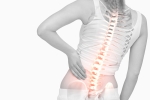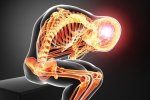Home »
Blog » Back Pain
| Stem Cell, PRP, Acupuncture in Queens & Long Island, New York
Back Pain | Stem Cell, PRP, Acupuncture in Queens & Long Island, New York
Tags: Back Pain | Posted on: 22-Jul-2020 | No of views: 5329 Exercises that help ease lumbar herniated disc pain can be difficult to find especially if you’re looking for ones you don’t have to perform lying on the floor. If you find it more comfortable to stand up or sit in a chair while you exercise, here are 3 beginner-level exercises you can try. Check with your doctor for his or her recommendations first.
Waiter’s Bow - The waiter’s bow is a standing exercise that strengthens the muscles in your buttocks, which makes things easier on your lower back. For support, you can do this exercise with your hands placed on a tall bed or stool in front of you.
Read more
Tags: Back Pain | Posted on: 20-Jul-2020 | No of views: 3710 Pain can entirely change our lives. Ongoing pain problems can lead to disabilities like not being able to work, drive, or even maintain a home. Pain in a dominant hand or arm can make it difficult to button a shirt, comb hair, or carry groceries. Low back pain can make it hard to sit, stand, bend, tie shoelaces, or just about anything else you can imagine. Intense, recurring headaches, like migraines, can make it difficult to concentrate, listen, read, eat, or even turn the lights on. This kind of pain – ongoing and significantly interfering with important life activities – is called high-impact chronic pain.
Read more
Tags: Back Pain | Posted on: 17-Jul-2020 | No of views: 3928 In some cases of osteoporosis, one or more vertebral bones can become so weak that they cannot fully support their load and develop tiny cracks. This type of fracture, called a vertebral compression fracture, can be painful and sometimes leads to worsening symptoms, such as tingling, numbness, weakness, or spinal deformity (kyphosis). Fortunately, you can take steps to lower your risk for vertebral compression fractures, as well as seek treatment if one occurs.
Read more
Tags: Back Pain | Posted on: 10-Jul-2020 | No of views: 3742 When upper back pain has lingered or not responded to rest and other self-care methods, a medical professional may be needed to develop a treatment plan that can reduce the pain.
Nonsurgical Medical Care for Upper Back Pain - Some of the more common medical treatments for upper back pain include:
Physical therapy. A physiatrist, physical therapist, or other qualified medical professionals can design a physical therapy program to meet the patient’s specific needs. Most physical therapy programs for upper back pain focus on strengthening and stretching the upper back’s muscles, as well as neck muscles above and core muscles below. Physical therapy starts gradually and typically progresses over a period of a few weeks or months, at which point the patient can switch to a maintenance program at home.
Read more
Tags: Back Pain | Posted on: 08-Jul-2020 | No of views: 4634 According to the American Academy of Pain Medicine, chronic pain affects approximately 100 million U.S. adults and costs $560 to $635 billion per year in direct medical treatment costs and lost productivity. Talk about a painful pill to swallow. Exercise is a common treatment for chronic pain. Depending on your current state of health, it may help decrease inflammation, increase mobility, and decrease overall pain levels, no additional medication required. Try a combination of the cardio, relaxation, stretching, and strength exercises below and you may feel some of your pain ease away over time.
Read more
Tags: Back Pain | Posted on: 03-Jul-2020 | No of views: 3657 If upper back pain develops without any signs of an emergency, most people can safely try to alleviate the pain on their own. Several self-care treatments for upper back pain exist. In some cases, a combination of one or more treatments is needed to help reduce the pain.
Read more
Tags: Back Pain | Posted on: 01-Jul-2020 | No of views: 3642 Treating chronic pain - Recognizing that chronic pain is a problem is the first step in finding treatment. Start by talking to your doctor about chronic pain symptoms. Together you can identify the source of the pain and come up with a comprehensive treatment plan that takes into account your overall health and lifestyle. Over-the-counter (OTC) and prescription medications are often used to manage pain. However, for many people, a combination of treatments is most effective.
Read more
Tags: Back Pain | Posted on: 29-Jun-2020 | No of views: 3466 As a doctor who sees firsthand the damage that chronic pain creates in people’s lives, I believe improving how we treat pain is the single most important public health challenge that we face but not because of the opioid crisis or the $ 600 billion spent each year on treating pain and lost productivity. From my perspective, chronic pain’s most devastating effect, hidden just below the surface of all the tragic stories, is its impact on our most essential core need love.
Read more
Tags: Back Pain | Posted on: 26-Jun-2020 | No of views: 13155 The course of upper back pain and how to treat it depends on the underlying cause of the condition. Even in cases where it seems obvious what started the upper back pain, such as an injury from a fall, the specific source of pain within the body can sometimes remain elusive. Regardless of whether the exact source of upper back pain can be determined, it helps to know the various potential causes in order to better narrow down which treatments may be best.
Read more
Tags: Back Pain | Posted on: 24-Jun-2020 | No of views: 3820 Diagnosis of Chronic Pain Syndrome - The first thing your doctor will do is take a thorough medical history. You’ll be asked things like: when your pain started, what it feels like (for example, burning and sharp or dull and aching), where it’s located, if anything makes it better or worse. Because certain conditions can lead to chronic pain syndrome, your doctor may order imaging tests to determine if there is joint or tissue damage that may explain your pain. For example, your doctor may order an MRI to determine if your pain is stemming from a herniated disk, an X-ray to see if you have osteoarthritis or a blood test to check for rheumatoid arthritis.
Read more
Love this Post? Spread the World






















